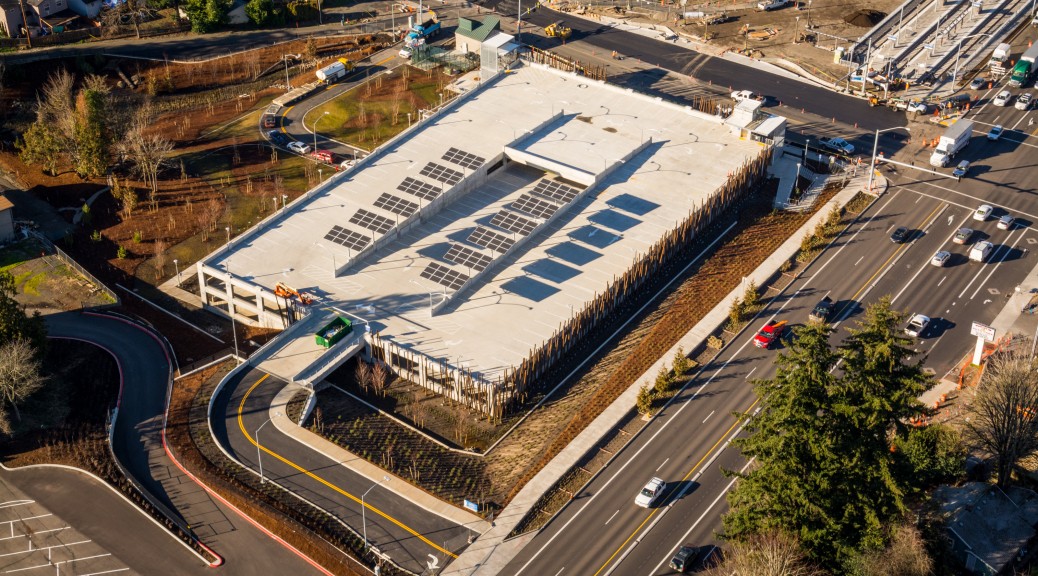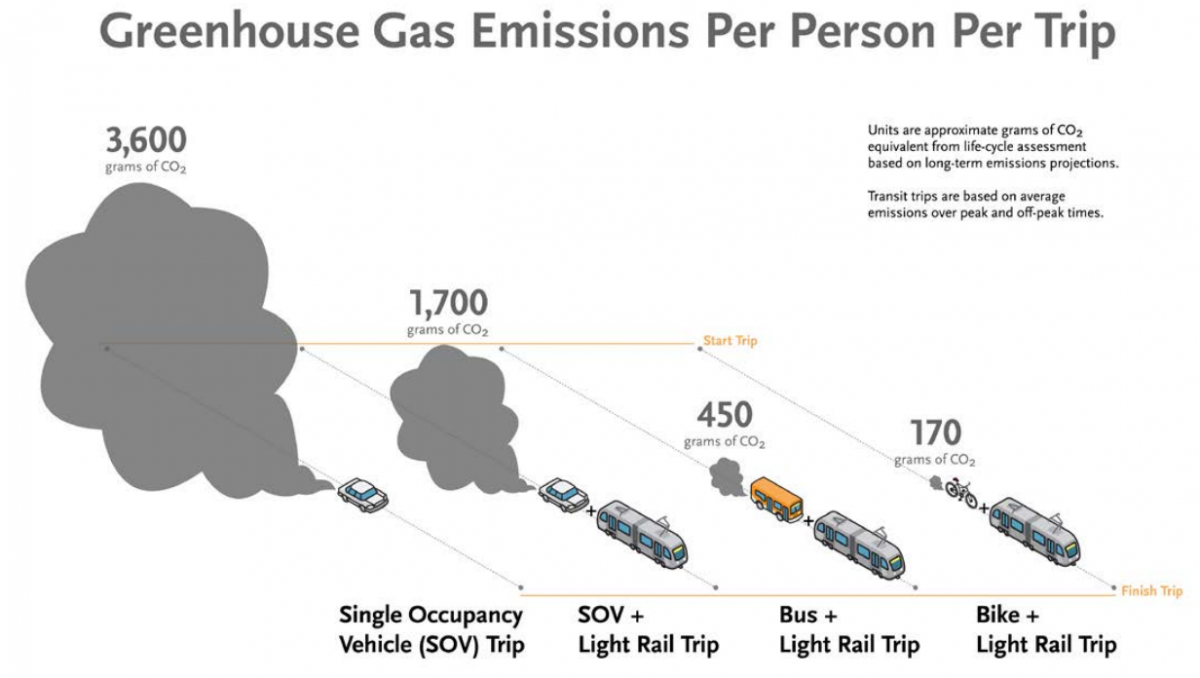
Editor’s note: This piece by former BikePortland news editor Michael Andersen is cross-posted from Sightline Institute. If you’d like to get involved in shifting tens of millions of dollars from parking garages to other ideas like protected bike lanes, affordable housing or bus improvements, there’s an important 15-minute public comment period coming up Monday, 9:10 a.m. at Tigard City Hall.
The people planning the Portland area’s next light-rail line seem to be steering away from a scenario where taxpayers pour $100 million of precious public-transit funding into a series of giant parking garages.
But unless the public speaks up in the next month, it’s possible that a handful of elected officials will push to build the garages along the “Southwest Corridor” through Southwest Portland, Tigard and Tualatin anyway—despite a mountain of evidence that spending the money on bus service, infrastructure for walking and biking, and transit-oriented affordable housing would do far more to improve mobility, reduce auto dependence and cut pollution.
“If we want to maximize transit ridership, park-and-rides are far less effective than other options… The answer is to make transit an efficient and attractive option without requiring auto use in the first place.”
— Madeline Kovacs from Sightline Institute, during a presentation to the project committee last week.
TriMet staffers seem to be looking to “update their approach” to park-and-rides based on a closer look at the factors that actually drive transit ridership, said Ramtin Rahmani, a volunteer on the community advisory committee for the Southwest Corridor Light Rail Project.
Rahmani (speaking only for himself) said last week that instead of pushing multi-level garages at several stations along the new rail line through Portland, Tigard, and Tualatin, TriMet’s staff members are making the case for surface lots, except at the end of the line near Bridgeport Mall. Their theory is that transit funding is better spent elsewhere and the surface lots would preserve the option of adding housing later.
This proposal isn’t perfect. TriMet has indeed redeveloped a few park-and-ride lots over the years, but it’s rarely removed parking spaces when doing so. That said, as I argued in November, surface lots are less bad than free parking garages. Here’s a slightly updated version of what my Sightline colleague Madeline Kovacs told the rail line’s community advisory committee when it met last week:
At $52,000 per stall, free park-and-ride garages are among the least effective ways taxpayers can spend money on public transit.
TriMet records show that 38 percent of MAX park-and-ride stalls sit empty on a typical weekday. But even if we generously assume a vacancy rate of just 20 percent for Southwest Corridor garages and a 45-year lifespan, then taxpayers are spending about $7 for every weekday a space will be used. The region’s taxpayers would be essentially buying more than the equivalent of a free transit pass for anyone who shows up at a garage, on one condition: that they show up in a car.
Advertisement
If we want to maximize transit ridership, park-and-rides are far less effective than other options. A 2016 King County Metro analysis found that capital investments to improve bus speed and reliability created more than three times as many riders per dollar as free park-and-rides. TriMet’s own analysis projected that even if several new garages are built for the Southwest Corridor, 85 percent of future trips will come from foot, bike or transfer traffic, not park-and-rides.
If we want to minimize congestion and pollution, the meaningful answer is not to convince 200, 300 or 500 cars—out of the 300,000 that drive to jobs in Portland each day—to pull off I-5 a few miles farther south. The answer is to make transit an efficient and attractive option without requiring auto use in the first place.
This can mean improvements to bus, walk and bike connections to rail. $100 million would be enough to install networks of low-stress protected bike lanes for miles in every direction around all 13 Southwest Corridor stops. It can also mean creating mixed-use, mixed-income developments within walking distance of rail stops—something that becomes much harder if you already dedicated the prime land near your rail stop to parking lots and garages. $100 million would be enough to create or preserve 600 more affordable homes along the corridor.
If we want to improve mobility for lower-income people, the solution is not to offer free parking to several hundred car-owning downtown workers in the hope that some of them might be poor. The solution is to spend the money on things we know disproportionately benefit low-income residents: better bus transit and affordable housing near transit. Both of these also boost overall transit use, creating a self-reinforcing cycle that helps improve the system for everyone.
The huge cost of new rail lines can sometimes make park-and-ride garages seem cheap by comparison. They are not. The cost of building something great, like a new public rail line used by tens of thousands of Oregonians, shouldn’t be allowed to conceal the boondoggle of free garages. Our region desperately needs to spend this money on things that will matter more.
Happily, TriMet staffers made some of the same points themselves to the advisory committee Thursday night. Take a look at this section of their slideshow. (Slide 41, for example: “Parking is expensive.” TrIMet puts it at $52,000 per garage space and $18,000 per surface lot space, plus $1 per space per day to operate.)
TriMet’s staffers also shared this image comparing greenhouse gas pollution for driving alone, for driving alone to a park-and-ride, and for taking bus or bike to a rail station:

But it’s not TriMet staffers who have de facto power over what ends up in the light-rail plan. The Southwest Corridor Steering Committee, which consists mostly of elected officials from suburban jurisdictions, will effectively decide how many transit dollars and how much transit-adjacent real estate to dedicate to park-and-rides, even within the City of Portland.
The agency could scrap its garage plans and solicit proposals from outside the agency for mixed-income housing developments. If a new building (probably with some shared parking on-site) can generate more transit riders than a parking lot alone, it could be allowed on the site instead.
Another option: The regional 2020 ballot issue that’s expected to fund this rail line could give cities money to install networks of protected bike lanes around each stop. That, along with relatively dense suburban station areas, can be the “secret weapon” of suburban transit ridership.
TriMet’s steering committee will briefly take up this issue at a meeting next week, and will go into depth at its next meeting on June 10.
Free park-and-rides might seem great for transit use. But look closely. They’re not: They soak up money that would be better used making transit better and easier to access. Yes, garages are visible. But that visibility is just a monument to our failure to make transit more attractive than driving in any way but one: free parking.
— Michael Andersen: (503) 333-7824, @andersem on Twitter and michael@sightline.org.
Never miss a story. Sign-up for the daily BP Headlines email.
BikePortland needs your support.

